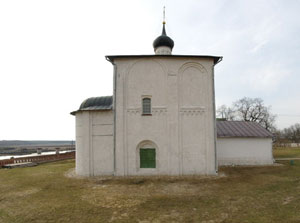Makarov N.A.*, Shpolyanskiy S.V.**, Dolgikh A.V.***, Aleshinskaya A.S.*, Lebedeva E.Y.*
*Institute of Archaeology RAS, Moscow
**State Historical Museum, Moscow (shpol@yandex.ru)
***Institute of Geography RAS, Moscow
 Key words: Northern-Eastern Rus, white-stone cathedrals, villages, analysis of spores and pollen, archaeobotanic materials, buriedplough horizons.
Key words: Northern-Eastern Rus, white-stone cathedrals, villages, analysis of spores and pollen, archaeobotanic materials, buriedplough horizons.
The article considers the developing history of the territory on the Nerl River in the village Kideksha where in 1152 one of the first white-stone cathedrals of the Northern-Eastern Rus (the Church of Boris and Gleb) was built up by Iurii Dolgorukii. The choice of this place for the church’s construction was connected with the special status of Kideksha as a Knyazh residence, probably erected on the place of the earlier administration center. However, the strong culture layers fracturing in the church yard did not give the opportunity to check this hypothesis for a long time. A culture layer, covered with building layer of 1152, was examined during the excavations in 2011. Based on the archaeological data, the results of morphological research of profiles and scientific analyses of the soil, the analysis of spores and pollen and archaeobotanic materials, it is possible to reconstruct some stages of the territory development. Till the end of the 1st millennium AD and during not less than a thousand and a half years there was the process of forming sod-podzol under the wood on the native the Nerl River valley side. Single fragments of the textile pottery of the 1st millennium BC evidently reflect the short-lasting period of the settlement in the beginning of the 1st millennium BC or seasonal economic activity.
At the end of the 1st millennium AD on the rock terrace a fixed medieval settlement appeared. Based on the finds of the carbonized macro remains, preserved in the culture layer, it is suggestible that the citizens of the settlement were involved in agriculture and the dominate crop was barley. Not later than the second half of the 10th century the settlement was abandoned. The forming of meadow soil on the culture layer was in progress on the place of the settlement. According to the composition of the pollen in spores and pollen specters, the surrounding landscape was open at that time. Not less than a hundred years after the plough, which was accompanied by vegetation burning, has been formed on the meadow part. The Church of Boris and Gleb was built by Iurii Dolgorukii on a farm field.







